Complete Solutions to SECTION A of chapter SAMPLE QUESTION PAPER 2020-21 (SCIENCE) of Class 10 book with complete answers and questions
| Class 10 | PHYSICS |
| Chapter | SAMPLE QUESTION PAPER 2020-21 (SCIENCE) |
| CBSE MODEL PAPER | SECTION A |
| Number Of Questions | 42 |
| Academic Year | 2023-24 |
List any two observations when Ferrous Sulphate is heated in a dry test tube?
View SolutionIdentify the products formed when 1 mL of dil. Hydrochloric acid is added to 1g of Sodium metal?
View SolutionWrite the chemical name and chemical formula of the salt used to remove permanent hardness of water.
View SolutionWhich of the following is not observed in a homologous series? Give reason for your choice.
View SolutionAt noon the sun appears white as
View SolutionA spherical mirror and a thin spherical lens have each a focal length of `- 15 cm`. The mirror and lens are likely to be
View SolutionThe image formed by a concave mirror is observed to be real, inverted and larger than the object. Where is the object placed?
View SolutionName the part of a lens through which a ray of light passes without suffering any deviation.
View SolutionIn the arrangement shown in figure, there are two coils wound on a non-conducting cylindrical rod. Initially the key is not inserted. Then the key is inserted and later removed. Then:
View SolutionDraw the magnetic field lines around a straight conductor carrying current. Name and state the rule to find the direction of magnetic field.
View SolutionTwo unequal resistances are connected in parallel. If you are not provided with any other parameters (eg. numerical values of I and R), what can be said about the voltage drop across the two resistors?
View SolutionSome work is done to move a charge Q from infinity to a point A in space. The potential of the point A is given as V. What is the work done to move this charge from infinity in terms of Q and V?
View SolutionVeins are thin walled and have valves. Justify
View SolutionHow is the wall of small intestine adapted for performing the function of absorption of food?
View SolutionOut of a goat and a tiger, which one will have a longer small intestine? Justify your answer.
View SolutionExplain how ozone being a deadly poison can still perform an essential function for our environment.
View SolutionGive reason why a food chain cannot have more than four trophic levels
View SolutionState the role of pancreas in digestion of food.
View SolutionAssertion: After white washing the walls, a shiny white finish on walls is obtained after two to three days.
Reason: Calcium Oxide reacts with Carbon dioxide to form Calcium Hydrogen Carbonate which gives shiny white finish.
View SolutionAssertion: Food chain is responsible for the entry of harmful chemicals in our bodies.
Reason: The length and complexity of food chains vary greatly.
View SolutionAssertion: Greater number of individuals are present in lower trophic levels.
Reason: The flow of energy is unidirectional.
View SolutionAssertion: A geneticist crossed a pea plant having violet flowers with a pea plant with white flowers, he got all violet flowers in first generation.
Reason: White colour gene is not passed on to next generation.
View SolutionAll living cells require energy for various activities. This energy is available by the breakdown of simple carbohydrates either using oxygen or without using oxygen.
Energy in the case of higher plants and animals is obtained by
View SolutionAll living cells require energy for various activities. This energy is available by the breakdown of simple carbohydrates either using oxygen or without using oxygen.
The graph below represents the blood lactic acid concentration of an athlete during a race of 400 m and shows a peak at point D.
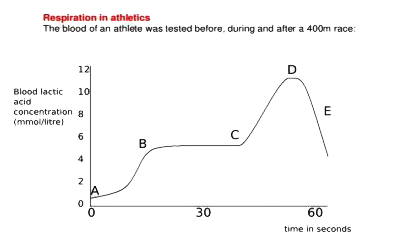
Lactic acid production has occurred in the athlete while running in the 400 m race. Which of the following processes explains this event?
View SolutionAll living cells require energy for various activities. This energy is available by the breakdown of simple carbohydrates either using oxygen or without using oxygen.
Study the graph below that represents the amount of energy supplied with respect to the time while an athlete is running at full speed.
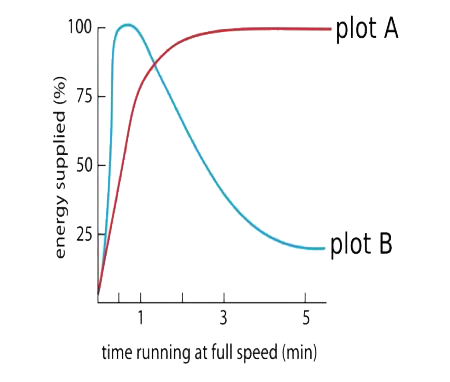
Choose the correct combination of plots and justification provided in the following table.
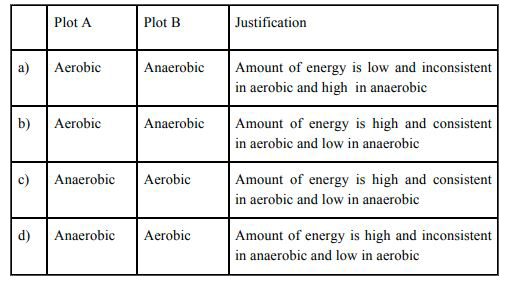
View SolutionAll living cells require energy for various activities. This energy is available by the breakdown of simple carbohydrates either using oxygen or without using oxygen.
The characteristic processes observed in anaerobic respiration are
i) presence of oxygen
ii) release of carbon dioxide
iii) release of energy
iv) release of lactic acid
View SolutionAll living cells require energy for various activities. This energy is available by the breakdown of simple carbohydrates either using oxygen or without using oxygen.
Study the table below and select the row that has the incorrect information.
View SolutionMetallic Character
The ability of an atom to donate electrons and form positive ion (cation) is known as electropositivity or metallic character. Down the group, metallic character increases due to increase in atomic size and across the period, from left to right electropositivity decreases due to decrease in atomic size.
Non-Metallic Character
The ability of an atom to accept electrons to form a negative ion (anion) is called non-metallic character or electronegativity. The elements having high electro-negativity have a higher tendency to gain electrons and form anion. Down the group, electronegativity decreases due to increase in atomic size and across the period, from left to right electronegativity increases due to decrease in atomic size
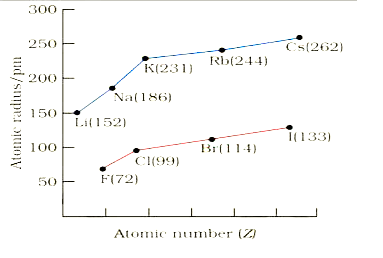
Which of the following correctly represents the decreasing order of metallic character of Alkali metals plotted in the graph?
View SolutionMetallic Character
The ability of an atom to donate electrons and form positive ion (cation) is known as electropositivity or metallic character. Down the group, metallic character increases due to increase in atomic size and across the period, from left to right electropositivity decreases due to decrease in atomic size.
Non-Metallic Character
The ability of an atom to accept electrons to form a negative ion (anion) is called non-metallic character or electronegativity. The elements having high electro-negativity have a higher tendency to gain electrons and form anion.Down the group, electronegativity decreases due to increase in atomic size and across the period, from left to right electronegativity increases due to decrease in atomic size

Hydrogen is placed along with Alkali metals in the modern periodic table though it shows non-metallic character
View SolutionMetallic Character
The ability of an atom to donate electrons and form positive ion (cation) is known as electropositivity or metallic character. Down the group, metallic character increases due to increase in atomic size and across the period, from left to right electropositivity decreases due to decrease in atomic size.
Non-Metallic Character
The ability of an atom to accept electrons to form a negative ion (anion) is called non-metallic character or electronegativity. The elements having high electro-negativity have a higher tendency to gain electrons and form anion. Down the group, electronegativity decreases due to increase in atomic size and across the period, from left to right electronegativity increases due to decrease in atomic size

Which of the following has highest electronegativity?
View SolutionMetallic Character
The ability of an atom to donate electrons and form positive ion (cation) is known as electropositivity or metallic character. Down the group, metallic character increases due to increase in atomic size and across the period, from left to right electropositivity decreases due to decrease in atomic size.
Non-Metallic Character
The ability of an atom to accept electrons to form a negative ion (anion) is called non-metallic character or electronegativity. The elements having high electro-negativity have a higher tendency to gain electrons and form anion.Down the group, electronegativity decreases due to increase in atomic size andacross the period, from left to right electronegativity increases due to decreasein atomic size
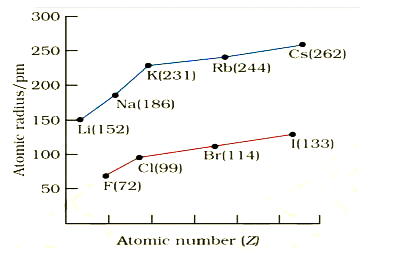
Identify the reason for the gradual change in electronegativity in halogensdown the group.
View SolutionMetallic Character
The ability of an atom to donate electrons and form positive ion (cation) is known as electropositivity or metallic character. Down the group, metallic character increases due to increase in atomic size and across the period, from left to right electropositivity decreases due to decrease in atomic size.
Non-Metallic Character
The ability of an atom to accept electrons to form a negative ion (anion) is called non-metallic character or electronegativity. The elements having high electro-negativity have a higher tendency to gain electrons and form anion. Down the group, electronegativity decreases due to increase in atomic size and across the period, from left to right electronegativity increases due to decrease in atomic size

Which of the following reason correctly justifies that “Fluorine (72pm) has smaller atomic radius than Lithium (152pm)”?
View SolutionSumati wanted to see the stars of the night sky. She knows that she needs a telescope to see those distant stars. She finds out that the telescopes, which are made of lenses, are called refracting telescopes and the ones which are made of mirrors are called reflecting telescopes.

So she decided to make a refracting telescope. She bought two lenses, `L_(1)` and `L_(2)`. out of which `L_(1)` was bigger and `L_(2)` was smaller. The larger lens gathers and bends the light, while the smaller lens magnifies the image. Big, thick lenses are more powerful. So to see far away, she needed a big powerful lens.Unfortunately, she realized that a big lens is very heavy. Heavy lenses are hard to make and difficult to hold in the right place. Also since the light is passing through the lens, the surface of the lens has to be extremely smooth. Any flaws in the lens will change the image. It would belike looking through a dirty window.
Based on the diagram shown, what kind of lenses would Sumati need to makethe telescope?
View SolutionSumati wanted to see the stars of the night sky. She knows that she needs a telescope to see those distant stars. She finds out that the telescopes, which are made of lenses, are called refracting telescopes and the ones which are made of mirrors are called reflecting telescopes.

So she decided to make a refracting telescope. She bought two lenses, `L_(1)` and `L_(2)`. out of which `L_(1)` was bigger and `L_(2)` was smaller. The larger lens gathers and bends the light, while the smaller lens magnifies the image. Big, thick lenses are more powerful. So to see far away, she needed a big powerful lens.Unfortunately, she realized that a big lens is very heavy. Heavy lenses are hard to make and difficult to hold in the right place. Also since the light is passing through the lens, the surface of the lens has to be extremely smooth. Any flaws in the lens will change the image. It would be like looking through a dirty window.
If the powers of the lenses `L_(1)` and `L_(2)` are in the ratio of `4:1`, what would be the ratio of the focal length of `L_(1)` and `L_(2)`
View SolutionSumati wanted to see the stars of the night sky. She knows that she needs a telescope to see those distant stars. She finds out that the telescopes, which are made of lenses, are called refracting telescopes and the ones which are made of mirrors are called reflecting telescopes.
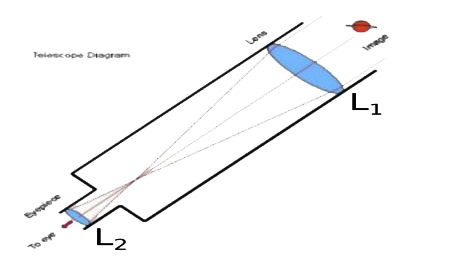
So she decided to make a refracting telescope. She bought two lenses, `L_(1)` and `L_(2)`. out of which `L_(1)` was bigger and `L_(2)` was smaller. The larger lens gathers and bends the light, while the smaller lens magnifies the image. Big, thick lenses are more powerful. So to see far away, she needed a big powerful lens. Unfortunately, she realized that a big lens is very heavy. Heavy lenses are hard to make and difficult to hold in the right place. Also since the light is passing through the lens, the surface of the lens has to be extremely smooth. Any flaws in the lens will change the image. It would be like looking through a dirty window.
What is the formula for magnification obtained with a lens?
View SolutionSumati wanted to see the stars of the night sky. She knows that she needs a telescope to see those distant stars. She finds out that the telescopes, which are made of lenses, are called refracting telescopes and the ones which are made of mirrors are called reflecting telescopes.
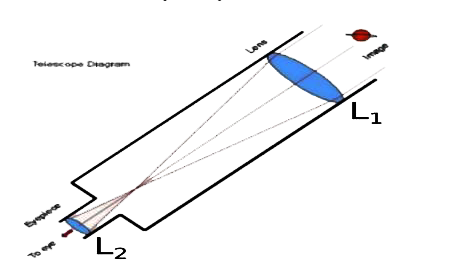
So she decided to make a refracting telescope. She bought two lenses, `L_(1)` and `L_(2)`. out of which `L_(1)` was bigger and `L_(2)` was smaller. The larger lens gathers and bends the light, while the smaller lens magnifies the image. Big, thick lenses are more powerful. So to see far away, she needed a big powerful lens. Unfortunately, she realized that a big lens is very heavy. Heavy lenses are hard to make and difficult to hold in the right place. Also since the light is passing through the lens, the surface of the lens has to be extremely smooth. Any flaws in the lens will change the image. It would be like looking through a dirty window.
Sumati did some preliminary experiment with the lenses and found out that the magnification of the eyepiece `(L_(2))` is 3. If in her experiment with `L_(2)` she found an image at 24 cm from the lens, at what distance did she put the object?
View SolutionSumati wanted to see the stars of the night sky. She knows that she needs a telescope to see those distant stars. She finds out that the telescopes, which are made of lenses, are called refracting telescopes and the ones which are made of mirrors are called reflecting telescopes.

So she decided to make a refracting telescope. She bought two lenses, `L_(1)` and `L_(2)`. out of which `L_(1)` was bigger and `L_(2)` was smaller. The larger lens gathers and bends the light, while the smaller lens magnifies the image. Big, thick lenses are more powerful. So to see far away, she needed a big powerful lens. Unfortunately, she realized that a big lens is very heavy. Heavy lenses are hard to make and difficult to hold in the right place. Also since the light is passing through the lens, the surface of the lens has to be extremely smooth. Any flaws in the lens will change the image. It would be like looking through a dirty window.
Sumati bought not-so-thick lenses for the telescope and polished them. What advantages, if any, would she have with her choice of lenses?
View SolutionA solenoid is a long helical coil of wire through which a current is run in order to create a magnetic field. The magnetic field of the solenoid is the superposition of the fields due to the current through each coil. It is nearly uniform inside the solenoid and close to zero outside and is similar to the field of a bar magnet having a north pole at one end and a south pole at the other depending upon the direction of current flow. The magnetic field produced in the solenoid is dependent on a few factors such as, the current in the coil, number of turns per unit length etc. The following graph is obtained by a researcher while doing an experiment to see the variation of the magnetic field with respect to the current in the solenoid. The unit of magnetic field as given in the graph attached is in milli-Tesla (mT) and the current is given in Ampere.

What type of energy conversion is observed in a linear solenoid?
View SolutionA solenoid is a long helical coil of wire through which a current is run in order to create a magnetic field. The magnetic field of the solenoid is the superposition of the fields due to the current through each coil. It is nearly uniform inside the solenoid and close to zero outside and is similar to the field of a bar magnet having a north pole at one end and a south pole at the other depending upon the direction of current flow. The magnetic field produced in the solenoid is dependent on a few factors such as, the current in the coil, number of turns per unit length etc. The following graph is obtained by a researcher while doing an experiment to see the variation of the magnetic field with respect to the current in the solenoid. The unit of magnetic field as given in the graph attached is in milli-Tesla (mT) and the current is given in Ampere.
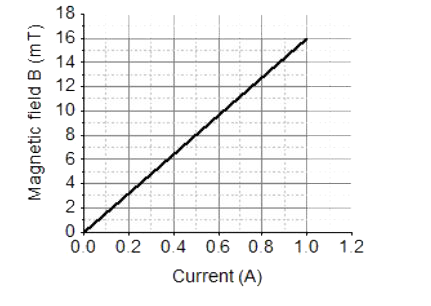
What will happen if a soft iron bar is placed inside the solenoid?
View SolutionA solenoid is a long helical coil of wire through which a current is run in order to create a magnetic field. The magnetic field of the solenoid is the superposition of the fields due to the current through each coil. It is nearly uniform inside the solenoid and close to zero outside and is similar to the field of a bar magnet having a north pole at one end and a south pole at the other depending upon the direction of current flow. The magnetic field produced in the solenoid is dependent on a few factors such as, the current in the coil, number of turns per unit length etc. The following graph is obtained by a researcher while doing an experiment to see the variation of the magnetic field with respect to the current in the solenoid. The unit of magnetic field as given in the graph attached is in milli-Tesla (mT) and the current is given in Ampere.

The magnetic field lines produced inside the solenoid are similar to that of …
View SolutionA solenoid is a long helical coil of wire through which a current is run in order to create a magnetic field. The magnetic field of the solenoid is the superposition of the fields due to the current through each coil. It is nearly uniform inside the solenoid and close to zero outside and is similar to the field of a bar magnet having a north pole at one end and a south pole at the other depending upon the direction of current flow. The magnetic field produced in the solenoid is dependent on a few factors such as, the current in the coil, number of turns per unit length etc. The following graph is obtained by a researcher while doing an experiment to see the variation of the magnetic field with respect to the current in the solenoid. The unit of magnetic field as given in the graph attached is in milli-Tesla (mT) and the current is given in Ampere.
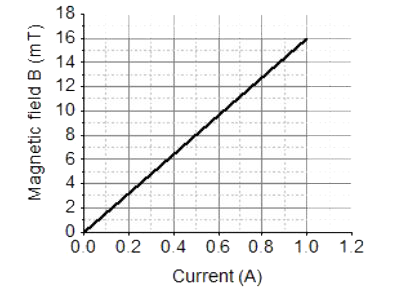
. a straight current carrying conductor
I. The magnetic field produced by the solenoid is inversely proportional to the current
II. The magnetic field produced by the solenoid is directly proportional to the current.
III. The magnetic field produced by the solenoid is directly proportional to square of the current.
IV. The magnetic field produced by the solenoid is independent of the current.
Choose from the following which of the following would be the correct statement(s).
View SolutionA solenoid is a long helical coil of wire through which a current is run in order to create a magnetic field. The magnetic field of the solenoid is the superposition of the fields due to the current through each coil. It is nearly uniform inside the solenoid and close to zero outside and is similar to the field of a bar magnet having a north pole at one end and a south pole at the other depending upon the direction of current flow. The magnetic field produced in the solenoid is dependent on a few factors such as, the current in the coil, number of turns per unit length etc. The following graph is obtained by a researcher while doing an experiment to see the variation of the magnetic field with respect to the current in the solenoid. The unit of magnetic field as given in the graph attached is in milli-Tesla (mT) and the current is given in Ampere.
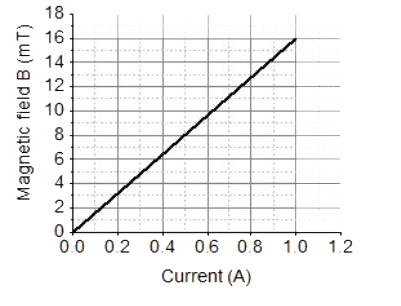
From the graph deduce which of the following statements is correct.
View Solution
SECTION A questions and complete solutions for chapter SAMPLE QUESTION PAPER 2020-21 (SCIENCE) of CBSE MODEL PAPER of Class 10